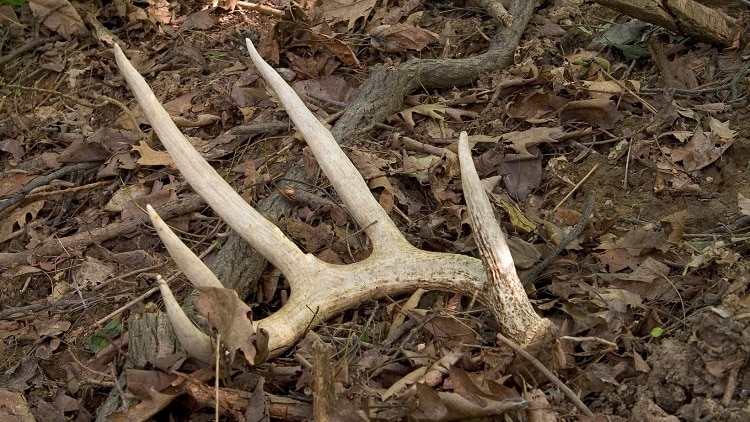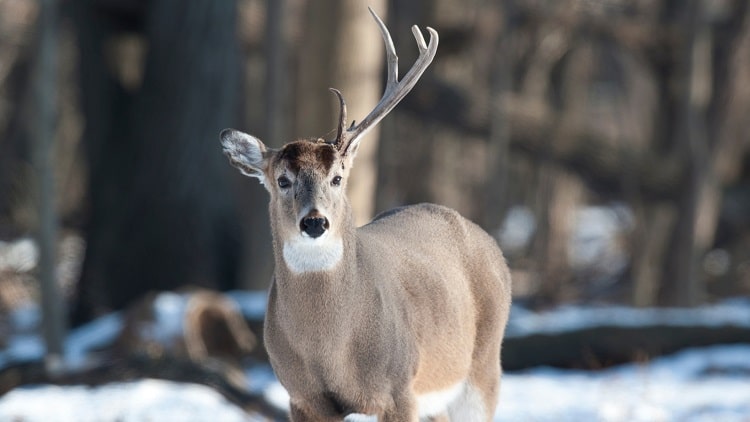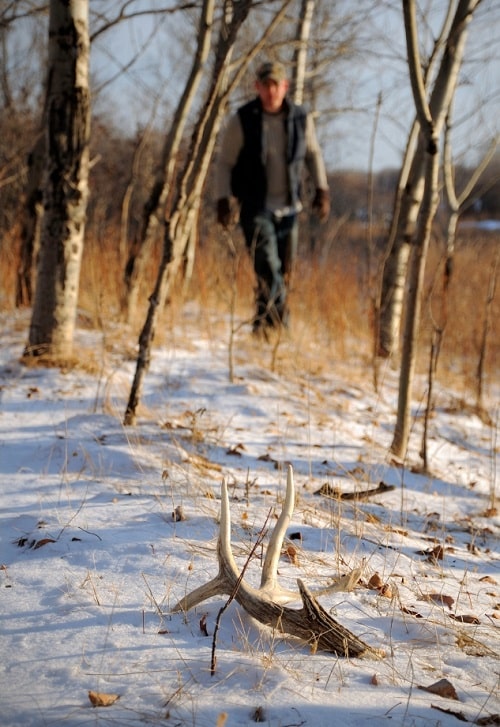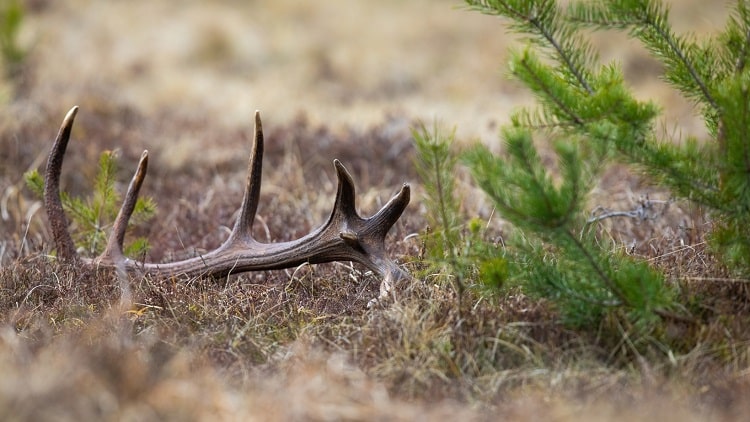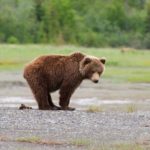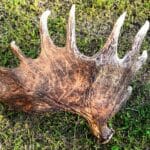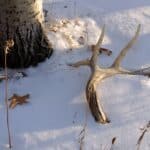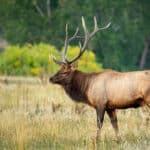Hunting is a great sport enjoyed by many. It’s an enjoyable challenge between you and the beast.
However, regular hunting requires certain skills and equipment. And you’re limited to specific hunting seasons. Plus, you have to pay for licenses and fees, and…
What if I told you there’s another type of hunting that just requires you to go into the woods armed with nothing but your wits and some sturdy footwear?
Shed hunting, also called antler gathering, is a “hunting” method that’s been taking off in recent years. It’s fun, challenging, and free. All you need is some dedication and knowledge about where to find sheds. They are typically spotted in and around places where the deer bed down or where they eat and drink. You don’t need any special gear to gather them, just some hiking boots and a good set of binoculars.
Let’s look at what goes into this sport so you can go from beginner shed hunter to expert in just a few hunts.
What is Shed Hunting?
The word “shed” can be used as a noun to refer to an animal part that’s fallen off the animal, whether it’s a snake’s skin, your dog’s winter coat, or a deer’s antlers.
So, when most people say they are going shed hunting, they’re telling you about their plans to search for discarded deer antlers.
That’s why some people refer to this activity as antler gathering. The word “hunt” implies more adventure, though. And some people call it bone-picking!
Any animal that sheds its antlers can be the subject of this activity, not just deer. Some people are lucky enough to find elk or even moose antlers!
Why Go Shed Hunting?
People can go shed hunting for a variety of reasons.
For some people, it’s a way to hunt deer without dealing with the expense or legal hurdles of actually hunting deer.
Plus, you can pay attention to where you’re finding antlers to learn the animal’s behavior so you can be more successful with a traditional hunt in the fall.
Other people find it to be an enjoyable hobby. It encourages you to head outside. And finding a high-quality set of shed deer antlers is satisfying.
There can be an economic purpose, too.
An antler makes excellent material for everything from knife handles to jewelry to chandeliers. This is great for craftsmen and DIY enthusiasts.
But deer antlers are also worth money.
A good set of whitetail antlers can sell for over $10 a pound. Some people make hundreds of dollars, or more, selling shed antlers to crafters and rustic furniture manufacturers.
Don’t expect shed hunting to be a get-rich-quick scheme, though. Finding enough antlers to make the big bucks takes a lot of time and effort!
Does Shed Hunting Hurt Deer?
A good question is whether hunting for shed antlers can harm the animals.
Well, antler shedding is a natural part of a deer’s life. They grow and then fall off every year. You won’t physically harm an animal by picking up its shed antlers.
However, shed hunters can disturb deer who are just trying to survive the harsh winter. Deer feel stressed when they’re disturbed by large numbers of shed hunters. They’ll expend precious calories trying to get away.
If repeated, this can reduce the animal’s chances of surviving the winter.
That’s why some states have limited antler gathering seasons. It’s also possible your state can shut down shed hunting across the state to help reduce the stress experienced by wintering animals.
Pay attention to your local laws when you go shed hunting and, whenever possible, avoid disturbing wildlife.
How to Start Shed Hunting: Beginner Skills
Antler gathering is the easiest possible way to go hunting.
At its easiest, you go for a hike and keep your eyes open for lost antlers. But you won’t find many if you stay close to the trail.
Put on some good hunting boots and grab a hunting backpack and prepare to go off the beaten path. You’ll find antlers where the deer, caribou, or elk spend their time, and these animals do not like to hang out around people.
This means you should look for feeding areas, bedding areas, drinking zones, and frequently used travel corridors.
But first, let’s look at when antlers are even available.
When Should You Look for Antlers?
While it’s theoretically possible to find shed antlers any time of the year, they degrade over time and are chewed up for their protein content. This means you should look for them when they’re freshly fallen.
Antlers are grown so the male animal can engage in mating behaviors. Once the rut is over, those antlers are excess weight so they fall off and a new pair grows.
The specific time when the animal starts to shed its antlers depends on the species and your part of the world.
Generally, though, antlers start to fall off in December and can continue into April. February and March are generally considered to be the two best shed hunting months.
Earlier is better for finding higher-quality antlers. They’ll have less time to be damaged by weather and other animals.
Later in the season is better for sheer volume. More deer will have lost their antlers so it’s easier to find some. If you’re new to shed hunting, I’d recommend starting later for this reason. It’s frustrating to tromp all over the forest and not find a single antler. You’ll still find good antlers from deer who delay dropping their rack, even late in the season.
However, if you’re in an area where the woods will be crowded with other bone pickers, you’ll want to start your search earlier in the season to avoid competition.
Where Do You Find Shed Antlers?
Deer love places where tree cover meets wide open areas. This lets them keep an eye out for predators as they eat or drink. This environment also lets them swiftly escape into the safety of the woods.
But they won’t hang out in an open field just because. They have needs to be fulfilled: food, water, and shelter.
Food sources are scarce in winter, and deer will search for as many food remnants as they can get.
Related: Best Places to Shed Hunt (Where to Look and Best States)
Crops such as soy and beans are frequent feeding grounds for deer. Corn is even better. Deer love corn and any stalks left over can help knock off old antlers.
Later in the season, though, look for areas of new greenery. Deer will snack on the freshest greens they can find when winter starts to give way to spring.
Hydration is necessary at all times of the year so make sure to check out all watering holes for freshly-dropped sheds.
Deer also spend a lot of time sheltered down in their bedding areas. Be careful when investigating known beds, though, since you don’t want to stress out the animal and force it to relocate.
What connects food, water, and shelter?
Travel corridors!
It’s worth finding need zones even if you don’t see any shed antlers because this lets you find the trails deer will make from point A to point B and back.
Follow these trails and you may find where a low-hanging branch has knocked the perfect rack off a buck.
How to Spot Fallen Antlers
Just like the deer that bears them for part of the year, antlers can be surprisingly tricky to spot.
They’re brownish or whitish objects found in nature, which is full of brownish and whitish objects.
Training your eye for spotting antlers in the woods takes a while. A big help is not actually to look for antlers.
Instead, look for specific antler parts.
Keep an eye out for tines. It can be easier to recognize a point instead of a whole antler, especially when there’s just a little nub sticking out of the snow.
Also, watch for the types of curves antlers take. An antler may be buried tine-down in the ground, tricking your brain if you’re trying to spot a whole antler. But that distinctively textured arch can draw the eye if you’re looking for a part of the antler, not the whole.
Binoculars can be helpful in your search so you can identify whether that bone-white object across the creek is an antler or something not worth your time. You can also use optics to glass a field for antlers.
And some people recommend going shed hunting during prime deer hunting time. The low morning sun can help cause an antler’s tines to pop out amongst its drab surroundings.
Once you’ve found one antler, chances are the other half of its set is nearby. Antlers come in pairs, after all. Stop where you’ve found the shed and look in a slow 360 degrees around you.
If you can, identify the deer’s direction and search in both directions. You may have found the first shed antler or the second one.
And if you can’t find that antler’s mate?
Well, sometimes a deer loses one antler and keeps the other one around for a day or two.
Tips to Help You Become a Better Shed Hunter
You must get out into the wild to become the best shed hunter. There’s nothing like real-world experience for learning the intricacies of antler gathering, especially since animal behavior varies by location.
However, you can boost your knowledge by learning from other shed hunters’ experiences.
Tip #1 – Look Where Deer Jump
For example, a good bone picker will look over the land and take note of any features that will make a deer jump.
Rough terrain, fences, creeks, and anything that causes deer to leap or stumble can be the perfect spot to check for antlers. The impact can jostle antlers and cause them to fall off.
Tip #2 – Look Where It’s Warm in the Morning
Deer often prioritize warm areas in the morning to help fight off the chill of the night. This means the savvy shed hunter will look to the south and east of large geographical features.
Southern slopes tend to be excellent sources of sheds.
Tip #3 – Look From Up High
Speaking of high areas, don’t be afraid to climb boulders to take advantage of the height.
Being farther up lets you glass your surroundings better. You may spot a shed that you’d miss right next to you!
And, unlike when hunting animals, you don’t have to worry about spooking your quarry by being too visible.
Tip #4 – Map What You Find
If you’re serious about shed hunting, you will want to track everything you find, from bedding areas to individual sheds. This will allow you to build up a body of knowledge that you can reference in regard to the movements of deer in your area.
You can do this manually with a map or GPS unit and notebook. Or take advantage of a hiking or hunting app on your smartphone.
This will help make your antler gathering trips more and more successful in succeeding years.
Plus, with enough tracking, you can identify individual bucks and catalog their development.
Deer are animals of habit. Use this to your advantage.
Tip #5 – Train Your Dog to Shed Hunt
Speaking of animals, dogs can be trained to sniff out and recover antlers.
You’ll want to start training them when they’re young. Partly to teach them that antlers aren’t chew toys!
Many professional hunting dog trainers can teach your canine this skill. It’s one they can learn alongside other hunting skills, too.
Tip #6 – Wear Soft Soles
Finally, I recommend wearing footwear with a thinner than usual sole when shed hunting.
You won’t need a thick sole to handle the heavy weight of carrying out a deer carcass. Instead, you want to be able to feel what’s under your feet.
This is because sheds can be surprisingly hard to see. However, they do not feel like a stick or rock when you step on them. More than one shed hunter has found great antlers with their feet instead of their eyes.
Conclusion
All the gear you need to go shed hunting is the same type of clothing you’d use for a hike.
Add a good backpack, a pair of binoculars, and a phone or GPS, and you’re as well kitted out as a bone picker can be, especially if you have your trusty dog by your side.
Shed hunting is a fun and rewarding hobby. Get out there and you’ll find the perfect rack lying there, just waiting for you!
FAQs
Can You Make Money by Shed Hunting?
It is possible to make money shed hunting but it requires a lot of time, effort, and luck.
Antlers can be sold on eBay and Etsy. Also, some companies advertise online when they are buying antlers.
Is Shed Hunting Hard?
Shed hunting is easier than usual hunting but is harder than hiking, though not by much.
Are Shed Traps a Good Idea?
Shed traps are a bad idea. They are designed to catch a deer’s loose rack and pull it off. However, bucks can get stuck in a shed trap before their antlers are ready to fall off and they can injure themselves as they try to escape.

